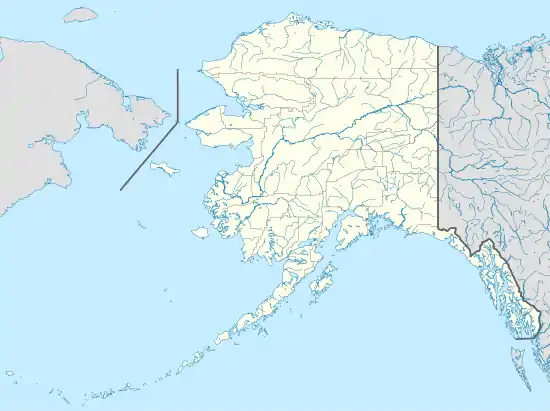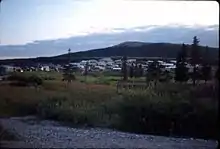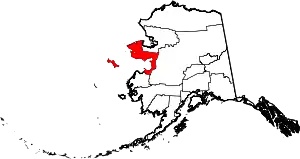Elim, Alaska
Elim (Central Yupik: Neviarcaurluq; Inupiaq: Nivviaqhchauġluq) is a city in Nome Census Area, Alaska, United States. At the 2010 census the population was 330, up from 313 in 2000.
Elim
Neviarcaurluq | |
|---|---|
 Elim Location in Alaska | |
| Coordinates: 64°37′4″N 162°15′24″W | |
| Country | United States |
| State | Alaska |
| Census Area | Nome |
| Incorporated | October 17, 1970[1] |
| Government | |
| • Mayor | LeRoy Bradley.[2] |
| • State senator | Donald Olson (D) |
| • State rep. | Neal Foster (D) |
| Area | |
| • Total | 2.66 sq mi (6.89 km2) |
| • Land | 2.66 sq mi (6.89 km2) |
| • Water | 0.00 sq mi (0.00 km2) |
| Elevation | 36 ft (11 m) |
| Population (2010) | |
| • Total | 330 |
| • Estimate (2019)[4] | 341 |
| • Density | 128.24/sq mi (49.51/km2) |
| Time zone | UTC-9 (Alaska (AKST)) |
| • Summer (DST) | UTC-8 (AKDT) |
| ZIP code | 99739 |
| Area code | 907 |
| FIPS code | 02-22250 |
| GNIS feature ID | 1401788 |
Geography
Elim is located at 64°37′4″N 162°15′24″W (64.617734, -162.256705).[5]
According to the United States Census Bureau, the city has a total area of 2.4 square miles (6.2 km2), all of it land.
Climate
Elim has a subarctic climate (Köppen Dfc).
| Climate data for Moses Point Airport, Alaska | |||||||||||||
|---|---|---|---|---|---|---|---|---|---|---|---|---|---|
| Month | Jan | Feb | Mar | Apr | May | Jun | Jul | Aug | Sep | Oct | Nov | Dec | Year |
| Record high °F (°C) | 42 (6) |
45 (7) |
44 (7) |
49 (9) |
75 (24) |
87 (31) |
84 (29) |
80 (27) |
69 (21) |
59 (15) |
39 (4) |
36 (2) |
87 (31) |
| Mean maximum °F (°C) | 31.5 (−0.3) |
29.4 (−1.4) |
33.0 (0.6) |
41.0 (5.0) |
62.4 (16.9) |
73.8 (23.2) |
75.8 (24.3) |
69.5 (20.8) |
59.1 (15.1) |
45.6 (7.6) |
33.9 (1.1) |
30.1 (−1.1) |
79.3 (26.3) |
| Average high °F (°C) | 8.8 (−12.9) |
8.0 (−13.3) |
14.7 (−9.6) |
26.2 (−3.2) |
43.5 (6.4) |
57.6 (14.2) |
61.2 (16.2) |
57.9 (14.4) |
49.0 (9.4) |
31.7 (−0.2) |
19.2 (−7.1) |
6.0 (−14.4) |
32.0 (0.0) |
| Daily mean °F (°C) | 1.7 (−16.8) |
0.7 (−17.4) |
6.2 (−14.3) |
18.2 (−7.7) |
36.3 (2.4) |
50.0 (10.0) |
54.2 (12.3) |
52.0 (11.1) |
41.9 (5.5) |
26.1 (−3.3) |
13.1 (−10.5) |
−0.6 (−18.1) |
25.0 (−3.9) |
| Average low °F (°C) | −5.4 (−20.8) |
−6.5 (−21.4) |
−2.4 (−19.1) |
10.1 (−12.2) |
29.1 (−1.6) |
42.4 (5.8) |
47.1 (8.4) |
46.0 (7.8) |
36.8 (2.7) |
20.5 (−6.4) |
7.0 (−13.9) |
−7.2 (−21.8) |
18.1 (−7.7) |
| Mean minimum °F (°C) | −36 (−38) |
−34.9 (−37.2) |
−29.2 (−34.0) |
−18.6 (−28.1) |
11.1 (−11.6) |
33.1 (0.6) |
37.6 (3.1) |
33.6 (0.9) |
22.9 (−5.1) |
1.6 (−16.9) |
−18.5 (−28.1) |
−34.0 (−36.7) |
−42.5 (−41.4) |
| Record low °F (°C) | −48 (−44) |
−49 (−45) |
−43 (−42) |
−39 (−39) |
−7 (−22) |
26 (−3) |
32 (0) |
28 (−2) |
16 (−9) |
−14 (−26) |
−42 (−41) |
−54 (−48) |
−54 (−48) |
| Average precipitation inches (mm) | 1.15 (29) |
0.92 (23) |
1.07 (27) |
0.91 (23) |
0.59 (15) |
0.73 (19) |
1.85 (47) |
4.20 (107) |
3.07 (78) |
1.21 (31) |
1.51 (38) |
1.04 (26) |
18.25 (463) |
| Average snowfall inches (cm) | 10.1 (26) |
9.2 (23) |
10.3 (26) |
7.4 (19) |
0.8 (2.0) |
0.0 (0.0) |
0.0 (0.0) |
0.0 (0.0) |
0.3 (0.76) |
4.8 (12) |
13.1 (33) |
9.8 (25) |
65.8 (166.76) |
| Source: WRCC [6] | |||||||||||||
Natural history
A number of flora and fauna are found in the Elim area. This is the westernmost location for the range of Black Spruce, Picea mariana.[7]
Demographics
| Historical population | |||
|---|---|---|---|
| Census | Pop. | %± | |
| 1920 | 162 | — | |
| 1930 | 97 | −40.1% | |
| 1940 | 100 | 3.1% | |
| 1950 | 154 | 54.0% | |
| 1960 | 145 | −5.8% | |
| 1970 | 174 | 20.0% | |
| 1980 | 211 | 21.3% | |
| 1990 | 264 | 25.1% | |
| 2000 | 313 | 18.6% | |
| 2010 | 330 | 5.4% | |
| 2019 (est.) | 341 | [4] | 3.3% |
| U.S. Decennial Census[8] | |||
Elim first appeared on the 1920 U.S. Census as an unincorporated village. It was formally incorporated in 1970.
As of the census[9] of 2000, there were 313 people, 84 households, and 69 families residing in the city. The population density was 128.9 people per square mile (49.7/km2). There were 106 housing units at an average density of 43.7 per square mile (16.8/km2). The racial makeup of the city was 5.11% White, 92.65% Native American, and 2.24% from two or more races.
Of the 84 households, 60.7% had children under the age of 18 living with them, 57.1% were married couples living together, 15.5% had a female householder with no husband present, and 16.7% were non-families. 14.3% of all households were made up of individuals, and 2.4% had someone living alone who was 65 years of age or older. The average household size was 3.73 and the average family size was 4.16.
In the city, the age distribution of the population shows 41.9% under the age of 18, 10.5% from 18 to 24, 26.2% from 25 to 44, 14.7% from 45 to 64, and 6.7% who were 65 years of age or older. The median age was 24 years. For every 100 females, there were 131.9 males. For every 100 females age 18 and over, there were 122.0 males.

The median income for a household in the city was $40,179, and the median income for a family was $40,893. Males had a median income of $25,938 versus $21,250 for females. The per capita income for the city was $10,300. About 8.0% of families and 7.9% of the population were below the poverty line, including 7.3% of those under age 18 and 12.5% of those age 65 or over.
Transportation
Airports
The Elim Airport is a state-owned airport with scheduled passenger flights. Also located in Elim is the Moses Point Airport, which is privately owned by the Elim Native Corporation.
Education
Elim is served by the Bering Strait School District. Aniguiin School serves grades Pre-K through 12.
Boulder Creek uranium mine controversy
In 2005, mining company Full Metal Minerals announced a partnership with Triex Minerals Corporation to develop a uranium deposit north of Elim.[10] Development of the site began with survey and exploration work in Sept 2005.[11] Initial drilling exploration was completed in July 2006,[12][13] confirming deposits of "sandstone-hosted uranium" at the Boulder Creek site in Death Valley, north of Elim.[14]
The Boulder Creek mine site is located on part of the Tubutulik River. Serious water and air pollution risks, including radioactive byproducts, have been identified with "in-situ leeching", the type of uranium mining proposed for the site.[15] Villagers have raised concerns that radioactive by-products of uranium mining would adversely affect the plants, fish, and wildlife on which they rely.[16] In September 2007, Irene Murray of Aniguiin High School in Elim wrote an open letter to Alaska Gov. Sarah Palin, drawing attention to projected impacts on the local environment and human health.[17] Protests led by Elim Students Against Uranium (ESAU)[18] have included demonstrations in 2008 and 2009 at the Iditarod Trail Sled Dog Race ceremonial start, and on the Iditarod trail in Elim.[19][20]
The village has raised legal concerns over the project that include an alleged failure by the federal Bureau of Land Management to provide adequate public notice and public comment periods regarding the Boulder Creek mine project.[21] Portions of the regulatory process are under the purview of the Nuclear Regulatory Commission.[15]
References
| Wikivoyage has a travel guide for Elim. |
- 1996 Alaska Municipal Officials Directory. Juneau: Alaska Municipal League/Alaska Department of Community and Regional Affairs. January 1996. p. 53.
- 2015 Alaska Municipal Officials Directory. Juneau: Alaska Municipal League. 2015. p. 59.
- "2019 U.S. Gazetteer Files". United States Census Bureau. Retrieved June 30, 2020.
- "Population and Housing Unit Estimates". United States Census Bureau. May 24, 2020. Retrieved May 27, 2020.
- "US Gazetteer files: 2010, 2000, and 1990". United States Census Bureau. 2011-02-12. Retrieved 2011-04-23.
- Moses Point Airport, Alaska - Period of Record : 3/1/1943 to 7/31/1967 Archived 2017-05-25 at the Wayback Machine. Retrieved November 10, 2019.
- C. Michael Hogan. 2008. Black Spruce: Picea mariana, GlobalTwitcher.com, ed. Nicklas Stromberg Archived October 5, 2011, at the Wayback Machine
- "Census of Population and Housing". Census.gov. Retrieved June 4, 2015.
- "U.S. Census website". United States Census Bureau. Retrieved 2008-01-31.
- "Full Metal Options Boulder Creek Uranium Property to Triex" Archived 2011-07-11 at the Wayback Machine 2005-09-28. Full Metal Minerals Press Release. Retrieved 2009-08-11.
- "Full Metal and Triex Boulder Creek Uranium Deposit - 2006 Drill Programs" Archived 2011-07-11 at the Wayback Machine 2006-01-16. Full Metal Minerals Press Release. Retrieved 2009-08-11.
- "Triex and Full Metal Continue Uranium Exploration at Boulder Creek" Archived 2011-07-11 at the Wayback Machine 2006-09-07. Full Metal Minerals Press Release. Retrieved 2009-08-11.
- "Boulder Creek Project" Archived 2008-07-23 at the Wayback Machine Triex Minerals Corporation. Retrieved 2009-08-13
- "Full Metal and Triex Announce Results from Drilling and Reconnaissance Exploration, Boulder Creek Uranium Project, Alaska" Archived 2011-07-11 at the Wayback Machine 2006-11-16. Full Metal Minerals Press Release. Retrieved 2009-08-11.
- "ACF Partners Join Village to Stop Uranium Mine: Effects could be devastating" 2008. Alaska Conservation Foundation. Retrieved 2009-08-11.
- "Iditarod a stage for mining protest", 2008-03-13. Sandra L. Medearis. The Nome Nugget
- "Student Letter to Governor Palin" 2007-09-20. BSSD Strait Talk. Retrieved 2009-08-11.
- "Elim Students Against Uranium" Archived 2011-07-27 at the Wayback Machine 2008-10. Indigenous Environmental Network. Retrieved 2009-08-11.
- "Alaska Natives protest uranium exploration on Iditarod Trail" Archived 2010-12-14 at the Wayback Machine 2009-03-14. Atlantic Free Press. Retrieved 2009-08-11.
- "Uranium mine threatens subsistence fishery in Native village of Elim, Alaska" Center for Water Advocacy. Retrieved 2009-08-11.
- "Native Village of Elim Alaska Fights Uranium Mine" Center for Water Advocacy. Retrieved 2009-08-11.
